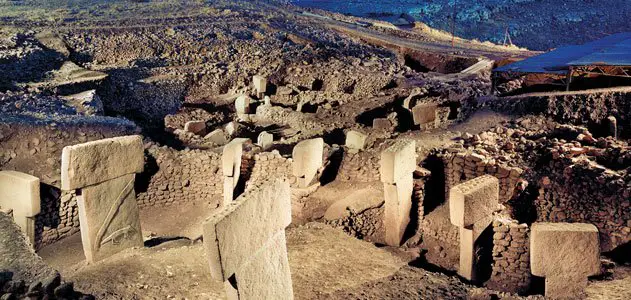
It is believed that the “Göbekli” people were organized groups of hundreds of hunters that guided whole herds of gazelles into traps. These people built a monument believed to be around 6,500 years older than Stonehenge and around 7,000 years older than the oldest of the Pyramids. Created some 12,000 years ago by unknown builders, Göbeklitepe is evidence of a sophisticated society existing on earth tens of thousands of years ago.
Located some six miles from Urfa, an ancient city in modern day Turkey, Gebekli Tepe is one of the greatest most important ancient sites ever discovered on the planet.
In this article, we bring you 20 mind-bending facts about this fascinating ancient site.
To date, experts have still NO IDEA who built this massive, fascinating site around 12,000 years ago
Göbekli Tepe is considered the world’s first temple. Most of this ancient site still remains buried.
Whoever built it, made sure the complex would survive along thousands of years, by backfilling the various sites and burying them deep under.
It is believed that Göbekli Tepe is a burial site, so far graves have not been found.
Göbekli Tepe is sometimes referred to as the Stonehenge of the desert.
Göbekli Tepe is a series of mainly circular and oval-shaped structures set on the top of a hill.
Gobekli Tepe was first examined—and consequently dismissed—by University of Chicago and Istanbul University anthropologists in the 1960s. Experts assumed that the mound was nothing more than an abandoned medieval cemetery.
Göbekli Tepe is believed to have been erected roughly twelve thousand years ago, around 10,000 BC.
Researchers have no obvious explanation for a highly advanced culture existing in Upper Mesopotamia at the end of the last Ice Age when the world was still populated by communities of hunter-gatherers, which were worried about the day-to-day survival.
The first excavation on the site were performed by Prof. Klaus Schmidt with the help of the German Archeological Institute in 1995.
So far, excavations and geomagnetic results revealed that there are at least 20 stone circles –temples— on the site.
All of the pillars at Göbekli Tepe are t-shaped and range in height from 3 to 6 meters.
Each of the t-shaped pillars has a weight of around 60 tons.
Even with today’s technology, we would have issues moving and positioning the 60-ton pillars of Göbekli Tepe.
It is estimated that a minimum of 500 individuals may have managed to move and position the massive pillars. However, in a world of chaos and self-preservation how were these people organized, and by whom?
It remains a profound mystery as to how ancient man managed to accomplish such monumental feat, and transport and place into position massive stones.
Mainstream scholars argue that the building proves of Göbekli Tepe required quarrying experts, transport specialists, planners, and ritual overseers.
This kind of organization –was most likely present over 12,000 years ago— and means that the builders of this marvelous ancient site may have already established a solid system and hierarchy.
It is believed that the t-shaped pillars are stylized human beings, due to the fact that most of them portray human extremities. However, experts have also found carvings of abstract symbols and a combination of scenes on the massive pillars at Göbekli Tepe.
According to experts, foxes, snakes, wild boars, cranes, wild ducks are the most commonly depicted animals at Göbekli Tepe.